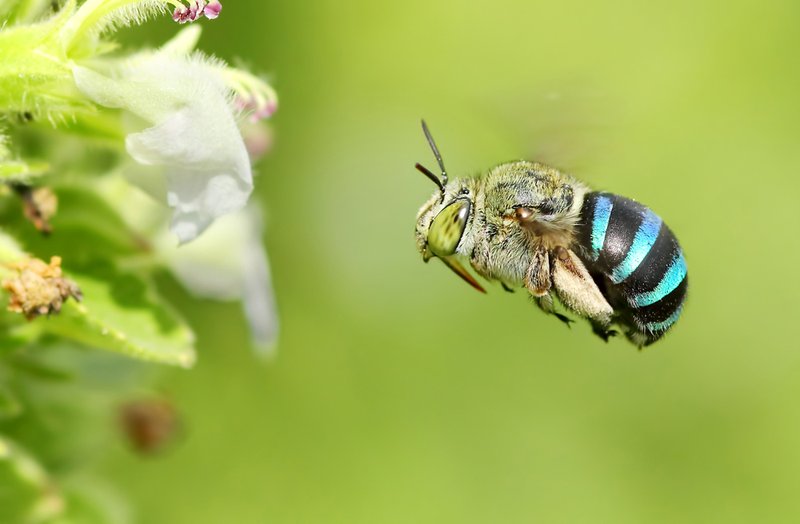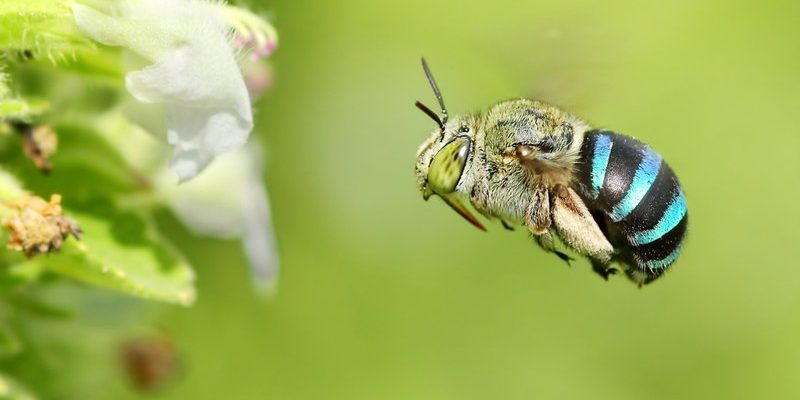
Blue banded bees, known scientifically as *Amegilla* species, are fascinating creatures. They have distinct blue markings that make them stand out, almost like they’re wearing a trendy outfit. While they can look intimidating, they’re generally more interested in flowers than in bothering humans. But here’s the thing: understanding their behavior and sting is crucial if you want to interact safely and feel comfortable sharing your space with these pollinators.
What Do Blue Banded Bees Look Like?
You might already know that the blue banded bee isn’t just any typical bee. It has a unique appearance that makes it easy to identify. These bees are small but not overly tiny. They usually measure around 12-15 mm in length, showcasing a striking color pattern.
They are characterized by their:
- Metallic blue and black stripes: The most notable feature is their vibrant blue bands. Think of them like stylish stripes on a sports jersey.
- Plump, fuzzy bodies: Their bodies are covered in fine hairs that help them gather pollen. It’s like their own fuzzy coat to keep them warm while they work.
- Long tongue: Blue banded bees have long tongues, which is perfect for reaching into flowers to collect nectar. It’s nature’s way of giving them the tools they need for their job!
Recognizing these features can bring you a sense of appreciation for their beauty and role in the ecosystem.
Are Blue Banded Bees Aggressive?
You might be curious about how these bees behave around humans. The good news is that blue banded bees are not aggressive. Unlike some other bee species, which can be territorial, these bees tend to be quite docile. You might even catch them lounging on flowers, sipping nectar, without a care in the world.
Here’s the thing: they’re much more interested in gathering food than in bothering you. They’ll typically only sting if they feel threatened. Imagine being approached by a curious dog while you’re busy eating. You might react if the dog gets too close! Similarly, blue banded bees will defend themselves if they think you’re a danger.
That said, it’s essential to keep a respectful distance. If you’re wearing floral patterns or strong scents, they might be drawn to you out of curiosity. Avoid swatting at them or making sudden movements, as this could startle them.
What About Their Sting?
So, are you at risk of getting stung by a blue banded bee? The sting itself is quite mild compared to that of a honeybee or wasp. If you do get stung, you might feel a quick pinch, but most people report feeling more startled than hurt.
To put it in perspective: if a honeybee sting is a solid jab, a blue banded bee sting might be a light tap. It’s also worth noting that not everyone reacts the same way. Some folks may experience minor redness or swelling, while others might not feel much at all.
If you happen to get stung, here are a few steps to take:
- Stay calm: Panicking makes it worse. Take deep breaths.
- Clean the area: Wash the spot with soap and water.
- Apply ice: This helps reduce swelling and numbs the pain.
- Watch for allergic reactions: If you experience severe pain, swelling, or difficulty breathing, seek medical help immediately.
How to Safely Observe Blue Banded Bees
You might want to see these vibrant insects up close. Observing them can be a delightful experience! Here are some friendly tips to do it safely:
1. Choose the right time: Blue banded bees are most active during the day, especially when it’s warm and sunny. Morning or early afternoon is best.
2. Wear light colors: Bright clothing can attract bees. Stick to neutral shades to keep a low profile.
3. Avoid strong scents: Fragrances, lotions, or hair products might catch their attention and make them curious about you.
4. Stand still and calm: If a bee approaches, avoid sudden movements. They’ll likely lose interest if you stay still.
By following these tips, you can enjoy watching bees in their natural habitat without the worry of being stung.
Why Are Blue Banded Bees Important?
You might be wondering why you should care about blue banded bees in the first place. These little buzzers play a vital role in our ecosystem. They are significant pollinators, helping plants reproduce by transferring pollen from flower to flower. This process is crucial for many fruits and vegetables we eat daily.
Consider this: without effective pollinators like blue banded bees, our food supply could dwindle, affecting not just our diets but also the entire food chain. These bees help sustain biodiversity, making our natural world richer and healthier.
In addition to their role in pollination, blue banded bees are also an indicator of environmental health. A thriving bee population often signifies a balanced ecosystem. Protecting them means protecting our environment.
How Can You Help Blue Banded Bees?
If you’re still with me, you might be feeling inspired to contribute to the well-being of blue banded bees. Here are a few simple things you can do to help:
- Plant native flowers: Blue banded bees love flowers like lavender, daisies, and bluebells. Create a bee-friendly garden!
- Avoid pesticides: Chemicals can harm bees and other beneficial insects. Try natural alternatives or organic methods.
- Provide water sources: A shallow dish of water with pebbles can give bees a place to sip without drowning.
- Educate others: Share what you know about blue banded bees with friends and family. The more people know, the more we can work to protect them.
Supporting blue banded bees can be as simple as making small changes in your garden or spreading the word. Every little bit helps!
Final Thoughts on Blue Banded Bees
Blue banded bees are captivating creatures that play a crucial role in our ecosystem. While they may look intimidating with their vibrant stripes, they are generally docile beings more focused on their floral adventures than on humans.
Understanding their behavior, sting, and importance can help you appreciate these little pollinators even more. With a little knowledge and care, you can enjoy the beauty of blue banded bees while keeping yourself safe. So, the next time you spot one in your garden, take a moment to admire its hard work—just remember to keep a respectful distance!

